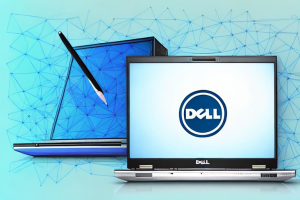How to upgrade the graphics card on a Dell OptiPlex 9020
8 min read
A dell optiplex 9020 computer with an open case
If you’re a serious gamer, or a graphic designer, or someone who simply wants a better visual experience while using your Dell OptiPlex 9020, upgrading your graphics card is a great option to consider. The process of upgrading your graphics card may seem overwhelming, but it is not necessarily as complicated as it may seem. With the right instructions, tools, and equipment, upgrading the graphics card on your Dell OptiPlex 9020 will be a breeze.
Understanding the Graphics Card and Its Importance
Before we dive into the nitty-gritty details of upgrading the graphics card on your Dell OptiPlex 9020, it is important to understand what a graphics card is and why it is important. A graphics card is a computer component responsible for rendering images and producing video signals that are shown on your computer screen. It is an essential part of your computer’s hardware, particularly if you’re a gamer or a graphic design professional who requires advanced 3D graphics capabilities and memory bandwidth.
One of the key benefits of having a dedicated graphics card is that it takes the load off your computer’s CPU, allowing it to focus on other tasks. This can result in faster and smoother performance, especially when running demanding applications or playing graphics-intensive games. Additionally, a graphics card can help improve the overall visual quality of your computer, providing sharper and more vibrant images, as well as smoother video playback.
When choosing a graphics card, it is important to consider factors such as the amount of memory it has, its clock speed, and its power consumption. You should also ensure that the graphics card is compatible with your computer’s motherboard and power supply, and that it fits within your budget. Upgrading your graphics card can be a great way to breathe new life into an older computer, or to take your gaming or design work to the next level.
Choosing the Right Graphics Card for Your Dell OptiPlex 9020
Choosing the right graphics card for your Dell OptiPlex 9020 is an essential first step in the process of upgrading your graphics card. It is important to consider factors such as your budget, the type of work you intend to do with your computer, and the compatibility of the graphics card with your Dell OptiPlex 9020. It is also important to choose a graphics card that offers enough memory bandwidth and VRAM to run the latest games or graphic design software.
Another important factor to consider when choosing a graphics card for your Dell OptiPlex 9020 is the power supply unit (PSU) of your computer. A high-end graphics card requires more power than a low-end one, so it is important to ensure that your PSU can handle the power requirements of the graphics card you choose. You may need to upgrade your PSU if it is not powerful enough to support your new graphics card.
Tools Needed to Upgrade Your Graphics Card on a Dell OptiPlex 9020
In order to successfully upgrade the graphics card on your Dell OptiPlex 9020, you will need some specific tools. These include a Phillips screwdriver, an antistatic wristband, a graphics card, and thermal paste.
It is important to note that before beginning the upgrade process, you should ensure that your power supply unit (PSU) is capable of handling the new graphics card. Upgrading to a more powerful graphics card may require a higher wattage PSU. You can check the wattage of your current PSU by looking at the label on the unit itself or by checking the specifications of your computer model online.
Preparing Your Dell OptiPlex 9020 for the Graphics Card Upgrade Process
Once you have all the necessary tools for upgrading your graphics card, the next step is to prepare your Dell OptiPlex 9020 for the installation process. This involves shutting down the computer, unplugging all cables and removing the computer cover, locating the PCIe slot on the motherboard, and ensuring that the power supply unit is adequate for the new graphics card you intend to install. It is important to be careful when handling delicate components of your computer and to make sure you are grounded to prevent any static discharge which can cause damage to your computer.
Before proceeding with the installation process, it is recommended to update the BIOS of your Dell OptiPlex 9020 to the latest version. This can be done by visiting the Dell website and downloading the BIOS update file. Updating the BIOS can help ensure compatibility with the new graphics card and improve system stability.
Once you have updated the BIOS, you can proceed with installing the new graphics card. Make sure to align the card with the PCIe slot and firmly press it down until it clicks into place. Then, secure the card with the screw provided. Finally, reattach the computer cover and plug in all cables. You can now turn on your computer and install the necessary drivers for the new graphics card.
How to Install a New Graphics Card in a Dell OptiPlex 9020
Installation of a new graphics card involves carefully inserting the graphics card into the PCIe slot on the motherboard, securing it with screws, and attaching the necessary cables. It is important to follow the manufacturer’s instructions and to be gentle so as not to damage the card or the PCIe slot.
Before installing a new graphics card, it is important to check the power supply unit (PSU) of your computer. A high-end graphics card requires more power than the existing one, and if the PSU is not powerful enough, it can cause instability and crashes. You can check the wattage of your PSU and compare it with the recommended wattage of the graphics card you want to install.
After installing the new graphics card, it is important to update the drivers to ensure optimal performance. You can download the latest drivers from the manufacturer’s website and install them on your computer. Updating the drivers can also fix any bugs or issues that may arise with the new graphics card.
Configuring the New Graphics Card After Installation
Once the new graphics card is installed, it is important to configure it properly to get the optimal performance. This involves downloading the latest drivers for the graphics card, updating the BIOS to ensure compatibility, and modifying the graphics card settings in the BIOS menu. This ensures that the new graphics card runs smoothly and does not cause any issues with your Dell OptiPlex 9020.
It is also recommended to check the power supply unit (PSU) of your computer to ensure that it can handle the power requirements of the new graphics card. If the PSU is not powerful enough, it may cause instability and crashes. Additionally, it is important to monitor the temperature of the graphics card during use, as overheating can also cause issues. Installing additional cooling solutions, such as fans or liquid cooling, may be necessary to prevent overheating.
Testing the Functionality of Your Upgraded Graphics Card on a Dell OptiPlex 9020
After the installation and configuration of the new graphics card, it is important to test its functionality to ensure that it is working optimally. You can test the graphics card by running benchmarking software, playing games, or using graphic design tools that require advanced graphics processing abilities. It is essential to ensure that the new graphics card is performing as expected.
It is also recommended to monitor the temperature of the graphics card during testing to ensure that it is not overheating. Overheating can cause damage to the graphics card and affect its performance. You can use software such as MSI Afterburner or HWMonitor to monitor the temperature of the graphics card. If the temperature exceeds the recommended limit, you may need to adjust the fan speed or add additional cooling to the system.
Troubleshooting Common Issues During and After Graphics Card Upgrade on a Dell OptiPlex 9020
During the graphics card upgrade process, some common issues may occur. These may include compatibility issues, driver problems, or conflicts with other hardware components. If any of these issues arise, it is essential to troubleshoot them to ensure that your computer performs correctly. This may involve seeking professional help or consulting the manufacturer’s guidelines for proper troubleshooting techniques to ensure that you do not harm yourself or your computer.
One of the most common issues that may arise during or after a graphics card upgrade is overheating. This can occur if the new graphics card generates more heat than the previous one, or if the cooling system in your computer is not sufficient to handle the increased heat. To prevent overheating, you may need to upgrade your cooling system or adjust the fan settings in your computer’s BIOS.
Another issue that may occur is a lack of power supply. Upgrading to a more powerful graphics card may require a higher wattage power supply than your computer currently has. If this is the case, you will need to upgrade your power supply to ensure that your computer can handle the increased power demands of the new graphics card.
Benefits of Upgrading Your Graphics Card on a Dell OptiPlex 9020
Upgrading the graphics card on your Dell OptiPlex 9020 offers numerous benefits, such as improved performance, faster frame rates for gaming, and better visual quality. This makes it an excellent option for gamers, graphic designers, and anyone else who requires advanced graphics processing capabilities. With the right tools, equipment, and instructions, upgrading your graphics card is an easy process that can significantly enhance your computing experience.
Upgrading the graphics card on your Dell OptiPlex 9020, while it may seem daunting, can make all the difference for those who require advanced graphics capabilities. By following the right instructions, choosing the appropriate tools and equipment, and being cautious and attentive, anyone can successfully upgrade their graphics card and enjoy a better computing experience.
One of the additional benefits of upgrading your graphics card on a Dell OptiPlex 9020 is that it can help extend the lifespan of your computer. As technology advances, software and applications require more advanced graphics processing capabilities. By upgrading your graphics card, you can ensure that your computer can handle these demands and continue to function at an optimal level for years to come.
Another advantage of upgrading your graphics card is that it can improve your ability to multitask. With a more powerful graphics card, you can run multiple applications simultaneously without experiencing lag or slowdowns. This is particularly useful for professionals who need to work with multiple programs at once, such as video editors or 3D designers.


